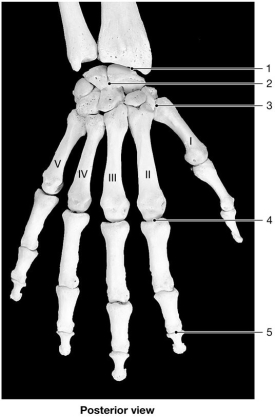A) the knee is protected by the patella.
B) the femur articulates with the tibia at the knee.
C) the knee contains seven major ligaments.
D) the knee contains fat pads to absorb shocks.
E) the knee is extremely resilient.
G) A) and C)
Correct Answer

verified
Correct Answer
verified
Multiple Choice
The movement of rotating a limb outward is called ________ rotation.
A) lateral
B) internal
C) medial
D) superficial
E) abductive
G) C) and D)
Correct Answer

verified
Correct Answer
verified
Multiple Choice
Small pockets of synovial fluid that reduce friction and act as a shock absorber where ligaments and tendons rub against other tissues are called
A) fat pads.
B) menisci.
C) bursae.
D) lacunae.
E) fasciae.
G) A) and D)
Correct Answer

verified
Correct Answer
verified
Multiple Choice
The elbow joint is extremely stable because
A) the ulna and humerus interlock.
B) the articular capsule is thin.
C) the capsule lacks ligaments.
D) several muscles support the joint capsule.
E) the joint lacks bursae.
G) All of the above
Correct Answer

verified
Correct Answer
verified
Multiple Choice
Structurally,the pubic symphysis is classified as a ________ articulation.
A) cartilaginous
B) bony
C) synovial
D) fibrous
E) diarthrotic
G) A) and C)
Correct Answer

verified
Correct Answer
verified
Multiple Choice
A common injury to the ankle occurs by excessive turning of the sole inward,called
A) eversion.
B) protraction.
C) dorsiflexion.
D) plantar flexion.
E) inversion.
G) A) and B)
Correct Answer

verified
Correct Answer
verified
Multiple Choice
Identify the incorrect pair.
A) synarthrosis; immovable joint
B) amphiarthrosis; slightly movable joint
C) chondrosis; freely moving joint
D) gomphosis; articulation between tooth and bone
E) They are all correct; there is no incorrect pair.
G) A) and E)
Correct Answer

verified
Correct Answer
verified
Multiple Choice
Which of the following is not a property of articular cartilage?
A) covered by perichondrium
B) lubricated by synovial fluid
C) enclosed by an articular capsule
D) similar to hyaline cartilage
E) smooth,low-friction surface
G) A) and D)
Correct Answer

verified
Correct Answer
verified
Multiple Choice
A general term for pain and stiffness that affects the skeletal or muscular system is
A) rheumatism.
B) atherosclerosis.
C) bursitis.
D) bunions.
E) arthritis.
G) None of the above
Correct Answer

verified
Correct Answer
verified
Multiple Choice
A joint where bones fuse together with bone tissue is called a
A) synchondrosis.
B) syndesmosis.
C) synostosis.
D) symphysis.
E) suture.
G) C) and E)
Correct Answer

verified
Correct Answer
verified
Multiple Choice
A herniated disc occurs when the
A) nucleus pulposus breaks through the anulus fibrosus.
B) disc slips out from between the adjacent vertebrae.
C) adjacent bones fuse.
D) knee is hyperextended.
E) inner core of the disc is squeezed to one side.
G) B) and D)
Correct Answer

verified
Correct Answer
verified
Multiple Choice
 Figure 9-2 Bones of the Wrist and Hand
Use Figure 9-2 to answer the following questions:
-Identify the type of joint at label " 1."
Figure 9-2 Bones of the Wrist and Hand
Use Figure 9-2 to answer the following questions:
-Identify the type of joint at label " 1."
A) hinge
B) condylar
C) gliding
D) saddle
E) pivot
G) A) and B)
Correct Answer

verified
Correct Answer
verified
Multiple Choice
Degenerative changes in a joint can be the result of all of the following except
A) bursitis.
B) bacterial infection.
C) mechanical stress.
D) immobilization of the joint.
E) inflammation.
G) C) and E)
Correct Answer

verified
Correct Answer
verified
Multiple Choice
Ankle extension is also called
A) dorsiflexion.
B) inversion.
C) eversion.
D) plantar flexion.
E) protraction.
G) A) and B)
Correct Answer

verified
Correct Answer
verified
Multiple Choice
Which of the following is not a property of synovial joints?
A) freely movable
B) lined by a secretory epithelium
C) covered by a serous membrane
D) contain synovial fluid
E) covered by a capsule
G) B) and D)
Correct Answer

verified
Correct Answer
verified
Multiple Choice
Which of the following is false?
A) The rotator cuff functions to limit the range of movements of the shoulder joint.
B) The shapes of the articulating surfaces within the joint help prevent movement in a particular direction and strengthen and stabilize the joint.
C) The tighter two bones are held together within a joint,the stronger the joint.
D) The more movement a joint allows,the stronger the joint.
E) The tension produced by muscle tendons surrounding a joint help stabilize the joint.
G) A) and B)
Correct Answer

verified
Correct Answer
verified
Multiple Choice
A synovial joint is an example of a(n)
A) synarthrosis.
B) amphiarthrosis.
C) diarthrosis.
D) symphysis.
E) syndesmosis.
G) A) and E)
Correct Answer

verified
Correct Answer
verified
Multiple Choice
The intercarpal articulations are ________ joints.
A) saddle
B) condylar
C) hinge
D) gliding
E) ball-and-socket
G) A) and E)
Correct Answer

verified
Correct Answer
verified
Multiple Choice
 Figure 9-2 Bones of the Wrist and Hand
Use Figure 9-2 to answer the following questions:
-Identify the type of joint at label "5."
Figure 9-2 Bones of the Wrist and Hand
Use Figure 9-2 to answer the following questions:
-Identify the type of joint at label "5."
A) hinge
B) condylar
C) gliding
D) saddle
E) pivot
G) B) and C)
Correct Answer

verified
Correct Answer
verified
Multiple Choice
In the knee joint,the medial and lateral menisci
A) are cartilages that bind the knee to the tibia.
B) act as cushions between the articulating surfaces.
C) take the place of bursae.
D) are found between the patella and femur.
E) are prominent fat pads to protect the articulating bones.
G) None of the above
Correct Answer

verified
Correct Answer
verified
Showing 41 - 60 of 127
Related Exams